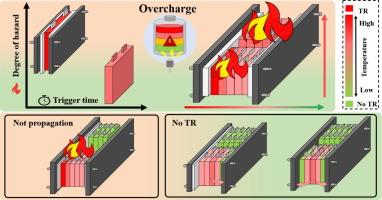多模块配置下钠离子电池过充热失控传播机制的跨尺度研究
IF 14.9
1区 化学
Q1 Energy
引用次数: 0
摘要
在电化学储能系统中,钠离子电池通常以“电池-模块-簇”的形式集成,但其跨尺度热失控触发风险及其传播机制尚不清楚。本研究揭示了过充条件下“电池-模块-集群”钠离子电池的跨尺度热失控触发和传播行为,并探讨了组件间距、触发电池位置和散热条件等关键因素对热失控传播行为的影响。结果表明,含过充电池模块的热失控传播遵循顺序触发模式,而下游模块的热失控则表现为同时触发模式,且严重程度更高。此外,增加模块间距或增强散热能力可以有效地减少热量积累,防止热失控的触发。在此基础上,提出了多维度评价策略,定量评价钠离子电池簇热失控的危险性。这一发现为储能系统中钠离子电池的安全设计奠定了基础。本文章由计算机程序翻译,如有差异,请以英文原文为准。

Cross-scale investigation of overcharge-induced thermal runaway propagation mechanism in sodium-ion batteries under multi-module configuration
In electrochemical energy storage systems, the sodium-ion battery is typically integrated in the form of a “cell-module-cluster”, but its cross-scale thermal runaway triggering risk and the propagation mechanism remain unclear. This study reveals the cross-scale thermal runaway triggering and propagation behavior of sodium-ion batteries of “cell-module-cluster” under overcharge conditions, and investigates the effects of key factors, including module spacing, triggering cell location, and heat dissipation condition, on the thermal runaway propagation behavior. Results demonstrate that the thermal runaway propagation in a module containing the overcharged cell follows a sequential triggering mode, while thermal runaway in the downstream module exhibits a simultaneous triggering mode with greater severity. Furthermore, increasing the module spacing or enhancing the heat dissipation capacity can effectively reduce the heat accumulation and prevent the trigger of thermal runaway. On the above basis, the multi-dimensional evaluation strategy is proposed to quantitatively assess the hazard of sodium-ion battery cluster thermal runaway. The findings serve as a foundation for the safe design of sodium-ion batteries in energy storage systems.
求助全文
通过发布文献求助,成功后即可免费获取论文全文。
去求助
来源期刊

Journal of Energy Chemistry
CHEMISTRY, APPLIED-CHEMISTRY, PHYSICAL
CiteScore
19.10
自引率
8.40%
发文量
3631
审稿时长
15 days
期刊介绍:
The Journal of Energy Chemistry, the official publication of Science Press and the Dalian Institute of Chemical Physics, Chinese Academy of Sciences, serves as a platform for reporting creative research and innovative applications in energy chemistry. It mainly reports on creative researches and innovative applications of chemical conversions of fossil energy, carbon dioxide, electrochemical energy and hydrogen energy, as well as the conversions of biomass and solar energy related with chemical issues to promote academic exchanges in the field of energy chemistry and to accelerate the exploration, research and development of energy science and technologies.
This journal focuses on original research papers covering various topics within energy chemistry worldwide, including:
Optimized utilization of fossil energy
Hydrogen energy
Conversion and storage of electrochemical energy
Capture, storage, and chemical conversion of carbon dioxide
Materials and nanotechnologies for energy conversion and storage
Chemistry in biomass conversion
Chemistry in the utilization of solar energy
 求助内容:
求助内容: 应助结果提醒方式:
应助结果提醒方式:


